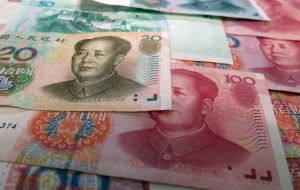MercoPress. South Atlantic News Agency
How has the US-China trade war affected forex?
 The US has slapped tariffs on Chinese exports such as steel, light machinery, and appliances, whilst China has retaliated by imposing tariffs on virtually all American-made products. Image: Pixabay
The US has slapped tariffs on Chinese exports such as steel, light machinery, and appliances, whilst China has retaliated by imposing tariffs on virtually all American-made products. Image: Pixabay  The biggest currency loser in all of this is the Chinese Yuan (RMB), which has fallen to its lowest value against the dollar in over a decade this year. Image: Pixabay
The biggest currency loser in all of this is the Chinese Yuan (RMB), which has fallen to its lowest value against the dollar in over a decade this year. Image: Pixabay There are many factors that affect the value of currencies and influence the flow of foreign exchange, but few have a more significant impact than a trade war.
So far, the ongoing conflict between the Doland Trump Administration and China sparked over issues such as IP theft and the alleged bad behavior of China's state-owned enterprises, has shed close to half a trillion dollars off the global economy, with the total cost by 2020 estimated to be close to $700 billion.
The US has slapped tariffs on Chinese exports such as steel, light machinery, and appliances, whilst China has retaliated by imposing tariffs on virtually all American-made products, from pharmaceutical to blue jeans and whiskey.
However, the impact of tariffs is only the tip of the iceberg. The ongoing trade war has had a dramatic impact on the value of various currencies - not just the US Dollar and Chinese Yuan, which has helped promote a flurry of foreign exchange (forex) activity around the world.
Perhaps surprisingly, given the doomsday warnings projected towards the White House, the dollar has risen to one of its highest values in years. For those trading via a forex broker in USA dollars it has been a lucky few months, as the dollar has risen multiple percentage points over the course of the year. And indeed, such platforms see trillions of dollars of transactions taking place every day.
Some of this might be related to growing optimism that the dispute will be solved, given that the dollar jumped significantly upon recent news that a trade deal on both sides is being considered. However, there is more to it than that. Forex traders know that when things get messy in the global economy, the dollar goes up.
This is partly because, as the global reserve currency, the dollar is a safe port in a storm for jittery investors. In addition, US-based investors tend to cut back exposure outside of the country during times of turmoil, which in turn pushes up the value of the dollar compared to other currencies.
Of course, the biggest currency loser in all of this is the Chinese Yuan (RMB), which has fallen to its lowest value against the dollar in over a decade this year. Whilst China still has a robust economy, its formerly stratospheric growth rates have slowed to a trickle, whilst investors have been pulling out of the country over the fear of incurring the wrath of the Federal Reserve.
Other losers have been currencies that rely on heavy flows of RMB or have heightened market exposure to China. These include the Indonesian Rupiah and the Malaysian Ringgit, which have both seen a depreciation of over 20% in the past two years.
One surprising winner is the Vietnamese Dong, which has seen a rise in value against the dollar and RMB despite the country's reliance on Chinese currency and trade flows. The main reason cited for this is the fact that the trade war has pushed Chinese manufacturers and businesses south into Vietnam, in search of cheaper labor and new markets as they try to recoup losses. The result has been a small boom in the Vietnamese economy, which goes to show that there are no easy predictions to be made in the world of forex.
What the rest of the year holds for currency values remains to be seen. A lot is riding on whether or not US-China relations improve this year. Whilst the signs are good, it's best to keep rooting for the greenback in the meantime.




Top Comments
Disclaimer & comment rulesCommenting for this story is now closed.
If you have a Facebook account, become a fan and comment on our Facebook Page!